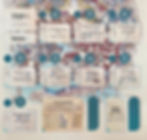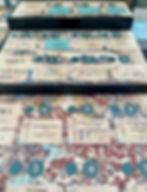Kinfire Council Board Game Review
- Jim Gamer
- Aug 11
- 12 min read
WBG Score: 9/10
Player Count: 2-6
You’ll like this if you like: A euro that looks gorgeous and offers meaningful decisions.
Published by: Incredible Dream Studios
Designed by: Kevin Wilson
This is a free review copy. See our review policy here.
The Kinefire Council Board Game is set in the world of Din'Lux, as seen in other "Kinfire" games, such as Kinfire Delve, which we reviewed here. And Kinfire Chronicles, which preludes this game narratively. But, you don't need to have played any of these others games to enjoy this one. Although, thematically, it would sure help. But mechanically, and aesthetically, this game is a thing of pure beauty. It is so slick in both looks and play. I am excited to tell you all about it. So, lets get it to the table and see how this plays.

How To Set Up Kinfire Council
Start by placing the two city board trays in the centre of the table, side by side. The board labelled Tier 3 should go on the taller tray, and the board labelled Tier 2 on the shorter tray. Then, lay the Tier 1 board flat on the table beneath the other two, aligning them so the stars between levels match up. Looks nice huh!
Next, place each district tile (numbered 1 to 18) on its matching space on the city boards, with the basic tan side facing up. You can upgrade to the other side during the game, so be sure to get them all tan side up for now. Then, take the Shady Dealer/Black Market special tile and place it on its designated space on the bottom city board with the Shady Dealer side showing.
Create a supply of all resource tokens nearby, sorting them into coin, food, common, rare, and magic resources. Set the coffers bowl next to this supply. Next, unfold the status board and place it next to the city boards. Shuffle both the research and decree decks separately and place them face down on their assigned spaces on the status board. Leave space to place two cards next to this later on in the game. Now, sort the skill tiles by type. There are three types, stack each one on its corresponding space on the status board. Either side can face up. Then, take three food resources from the supply and place one in each of the top three spaces in the right-hand column of the City Needs track. Then place the black Cult score marker on the zero space of the score track.

Now, place the threat board near the city boards. Shuffle the threat deck and place it face down beside the threat board, along with the supply of trouble tokens. Then, without looking at them, draw the top three cards from the threat deck and place them face down near the play area. Lay the Hidden Threats tile on top of this pile. These are the hidden threats and they must remain unrevealed until the end of the game. If more hidden threats are gained during play, add them to the pile under the Hidden Threats tile. Them set aside the special threat tiles, such as Rubble and Sea Beast, and place them near the threat board. Finally, to set up the main board, place all twenty cultist chits into the Cult bag and place it on the table.
Next, lay out the six worker sheets. Shuffle the Councilor (devastatingly spelt with only one "el") sheets and randomly deal one Councilor sheet face up next to each worker sheet.
Choose a starting player at random and give them the Speaker’s Medallion (this is the first player marker and we have a very pretty metal one that was part of the Kickstarter exclusive!).
Each player takes the Seeker standee, worker chits, influence tokens, score marker, and +50/+100 token that match their selected worker sheet. Then, in turn order, place your score markers on the score track. The first player places theirs on the first space, the second player on the second space, and so on. Each player places their Seeker on the indicated space on their worker sheet along with their worker pieces. The number you have varies based on player count: five in a two-player game, four with three players, three each in a four-player game, and two each for a five or six-player game.

Next, place the lighthouse tracker near the city boards and put the progress marker on the bottom space of the track. Shuffle the five lighthouse site sheets and place them in a face down stack next to the lighthouse track. Turn the top sheet face up. This will count as your round tracker as you play through each round. As such, its best to discard each one after each round so you know how many rounds are left. Finally, place all sentry tokens face up near the city boards. Spread them out so each player can clearly see which tokens are available. You are now ready to play.
How To Play Kinfire Council
The game runs through five rounds. Each round has three phases: a set-up phase called Sun's Rise, the main action phase called Day's Light, and a clean-up phase called, you guessed it, Night's Fall. Players are looking to score points from various means and finish with the most points, but also control the Cultists, who will be scoring their own points during the game.
Each player will have their own unique asymmetric power based on the character they have chosen during setup. Each power can be quite powerful and game-changing. Matching your unique skills with a strategy in the game is crucial to victory.
In Sun's Rise you will draw the top two cards from the Decree deck and read them both to all players. During the main phase, players will vote on these, to decide which card comes into play. They will introduce new orders, permanent rule changes, or events that trigger if a specific card is not passed.

The second thing to do in Sun's Rise is to draw three Cultist tokens from the draw bag. They are then placed onto the board on the matching spot. Each Cultist is numbered one to 18 like the board. This spot is now blocked for this round until that Cultist is arrested. Then, add a card to the matching space on the threat board. For example, if the Cultist is numbered one to six, add a card to the one to six space. If there is already a card there, add a trouble token to that card. Each card has a number on the top left. When the card has the matching number of trouble tokens on it to the number in the top left, the card is triggered. Any cards drawn with a zero are triggered immediately. Cards with a dash stay in play until they are thwarted during the main phase of the game. You will thwart cards by paying the required resources as shown on the bottom of the card, an then gaining the benefits shown on the bottom right. This is an action you can take by sending your leader to the spaces on the threat board itself, or from one of the spaces on the main board. where you can do the sane, but for an additional cost.
In Day's Light players will now take it in turns to place one of their workers onto one of the many spaces on the board. There are 18 spots on the main board that all workers can go to; then two extra spaces that change each round on the Lighthouse, and three spots on the threat board that only your leader can go to. You can see this clearly with the hexagonal spot rather than the circular spots on the main board. Each spot can only hold one worker, apart from a few spaces on the bottom tier of the main board, where you can send multiple workers.
The main actions on the board are grouped by the three tiers of the board. The bottom tier has zero cost. The middle tier costs one coin, paid into the city coffers. The top tier, with more powerful actions, costs two coins, again paid to the coffers. Certain actions let players gain coins from the coffers, so it's important to add the coins there, not back into the general supply. But the coffers are emptied at Night's Fall, so they don't build up that much.

After you place your workers, you can carry out the action shown on the spot you went to. This is mainly to gain or trade resources, but a few other options will open up later on, as you upgrade the worker placement locations. One of the actions at the bottom of the bottom tier allows you to spend money and resources to make these upgrades. To do this, place a worker there, pay the cost, flip over your chosen space, and then add an influence token to it if you wish. Then, whenever anyone else goes there for the rest of the game, you will gain the resource shown on the top left of this flipped token. Upgrading locations also gains you a lot of points.
If you place your worker next to a Cultist, orthogonally, instead of carrying out the locations usual action you can arrest the Cultist instead. Taking it off the board and adding it to your play area. This helps all players by removing the Cultists from the board, but also, you can now use this Cultist as a resource for various trade actions on the board.
Once players have carried out a location action, or arrested a Cultist, you may then carry out an errand if you want. This means spending one of your Influence tokens (you start with four but can get more) and placing it either on one of the spaces on the City Needs board, then putting the matching resource there back into the supply; or onto the Lighthouse, and paying the required resources to build the lighthouse up either one, two, or three levels. You don't have to run an errand, and you won't have enough Influence tokens to do this every time, but the points from the Lighthouse are huge and the City errands need to be run otherwise you will have more Cultists next time.

When you pay a City need resource, you will gain two points for doing so. At the end of the round, during Night's Fall, for any unpaid City resource, an additional Cultist will be drawn in the next round. So, to avoid the game getting harder, the Cultist scoring more points, and for your own point benefits, you will want to do this. You start with just three City needs, but more will be added as you play the game. They stay each round, and simply grow as your city gets more demanding! But they need to be met each round in exchange for two points.
The Lighthouse is built each round then reset at Night's End. As it is built higher each round, the number of points awarded to the players that contribute towards its construction is also increased. Each round you will have a new lighthouse card showing the resources needed to build either one, two, or three levels. To do this, run an errand here, place an Influence token next to the level you are building, discard the required resources, then move the lighthouse tracker up the matching amount of spaces. Then, during Nightfall, you will score a multiplier as shown by the level you reached for each level you build. For example, if you get it up to the top level, which offers three points per level built, and you built it up nine levels, that's 27 points! Damage may be added to the lighthouse during the round though, and this will knock the Lighthouse back down a level for each damage token that remains at the end of the round. As the track moves up, increasing the multiplier, the points awarded to the Cultists, as shown on the right of the track, is also reduced.
Other actions during Night's Fall require you to resolve the docket. Here, the card with the most votes is activated. Unless one of the cards was a Crisis, in which case, the Crisis activates unless it received the most votes. Then, if any Cultists remain on the board (but they probably won't, it's good to arrest them and use them as resources) they will trigger the matching card in the threat board again.

Players will then retrieve all the influence tokens they placed out as well as all their workers. The city coffers are emptied, and the next round then begins, unless this is the fifth round, in which case final scoring takes place. The cards beneath the hidden threat are revealed, and the Cultist scores points for every card here. Points are shown on the bottom right of the card and will range a lot, and can be quite high. Even if you were quite far ahead, the Cultist can catch up at this point. After this, if any player remains ahead of the Cultist and has the most points, they take the victory.
In a three-player game or higher, players can win another way, though. Some worker spaces and cards let you gain Cult influence. When you do, the Cult also scores one point. For example, at The Red Gull in district four, you can trade two coins to gain one Cult influence and give the Cult one point. To gain Cult influence, take one of your unused influence tokens and place it in the Cult Influence area on the status board. If you’ve already used all your tokens, you must convert one into a Cult influence token instead. The player with the most Cult influence becomes the Conspirator. Their token is placed in the top right space of the Cult Influence area. If there’s a tie, the player who gained Cult influence most recently becomes the new Conspirator. You would do this because then at the end of the game, if the Cultists score the most points, the player who is currently the Cult Conspirator wins the game, even if they have fewer points than another player.
The thing about the game I love the most is the research cards. These come from the Scholars’ Circle and give you special effects that can range in power and be incredibly helpful. Each card tells you when it can be used, either during your turn or during a certain part of the game. You can play more than one card at a time and hold as many as you want. If more than one player wants to use a research card at the same time, go in turn order. If the deck runs out, shuffle the discard pile to make a new one.

Another way to score a lot of points is via the Sentry tokens. Points from these tokens are award when you do certain things, like meeting City Needs, making lighthouse deliveries, arresting criminals, upgrading districts, stopping threats, or leading a decree. When you get a Sentry token, keep it near your Councilor sheet and try to remember what action rewards you extra points. It's easy to forget, especially when you have a few!
The Shady Dealer space on the main board is a place where you can trade points or a research card for coins. If district three (The Tumbles) is upgraded, flip the tile over to the Black Market side. This lets you use it twice per turn instead of once. Its a great place to go when you are unsure what to do, or just need some money quick!
Kinfire Council Board Game Review
Kinfire Council is a smart, beautiful game packed with layered decisions and player interaction. At first glance, it’s a slick euro with stunning art and components, but within this stellar production is a clever blend of resource management, worker placement, and deep strategy. The city evolves as players upgrade districts, vote on new rules, and race to build the lighthouse each round. It’s fun seeing how different player powers all interact, and there’s something satisfying about working together to keep the Cultists at bay, while actively trying to beat each other too.

The best part might be how dynamic and reactive each round feels. Every session plays out differently depending on the decrees that pass, threats that appear, and player choices. You have to adapt constantly, balancing short-term actions with long-term planning. Will you invest in upgrading the city, focus on building the lighthouse, or sneakily side with the Cult to win a different way? There’s real tension in the vote phase and plenty of room for clever plays with Research cards and player power combos.
It’s not all smooth sailing though. Kinfire Council can be a bit much on your first go. There’s a lot to learn and set up, especially if you’re teaching new players. Some rules (like the Cult scoring or the 18 different worker placement spots) might take a round or two to click. But the game really shines once everyone knows how things work and for the right group, that depth and scale is part of the appeal.
Kinfire Council is a big, bold game that offers a fresh mix of theme, interaction, and strategy. Whether you're trading with the Shady Dealer for a quick coin, racing to arrest Cultists, or pushing a risky decree through the vote, there’s always something exciting to do on your turn. The game rewards long-term strategy and short-term cunning equally, and with multiple ways to score big and win, every decision matters. It’s a standout design that’s easy to recommend to experienced gamers ready for a new challenge.

Pros
Gorgeous production with standout art, components, and table presence.
Deep and satisfying decision space with asymmetric powers and evolving strategies.
Highly interactive—voting, shared goals, and limited worker placement locations create real tension.
Multiple ways to score points and win, offering strong replayability.
Unique mechanics like errands and district upgrades feel fresh and rewarding.
Cons
Setup and teach can be overwhelming for new players.
18 worker placement options take time to fully grasp.
Early misplays can be punishing if up against a more experienced player, particularly for those unfamiliar with the asymmetric powers.
Kinfire Council is a stunning and smart euro that blends worker placement, with asymmetric powers, voting, and resource management. It’s ambitious in scope and not shy about asking a lot from its players for game one, but it pays that off with meaningful choices, layered interaction, and evolving gameplay. Once the worker placement options settle in, it becomes a thrilling game of influence, risk, and clever plays. If you enjoy big-box strategy games and don’t mind a bit of learning curve, this is one council meeting you’ll want to be part of.

